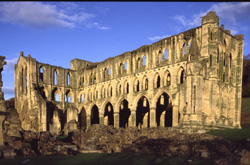 |
 |
 |
 |
 |
 |
 |
|
The arrival of the Cistercian Order in Yorkshire (1/1) |
|||
The Cistercians’ arrival in Yorkshire was initiated and directed by Bernard of Clairvaux, who wrote to Henry I in 1131 announcing his intention of making an outpost in the North. Bernard describes the venture in terms of a military campaign: monks of Clairvaux were to assess the area and report back to him; he would then send an army of monks to occupy the outpost, and from there infiltrate the country.
The North of England was in many ways a suitable choice for Bernard’s mission. The landscape here was ideal for Cistercian settlement, for it was desolate and wild, consistent with the White Monks’ ideal of the wilderness. Moreover, the North was ripe for Cistercian expansion, for, in contrast to the South of England, there were relatively few religious houses. Bernard was also familiar with this area, for several of his leading monks at Clairvaux were from Yorkshire, and he was in personal contact with key figures such as Archbishop Thurstan of York, and Henry Murdac, master of the schools at York. Rievaulx Abbey was founded as the first Cistercian ‘outpost’ in the North in 1132. It was located in a deep valley by the River Rye, described by one contemporary as ‘a fearful place of solitary waste’. The site was provided by the founder of Rievaulx, Walter Espec, who was a royal justice; his castle at Helmsley was located a few miles from the abbey. On their way to Rievaulx the colony of Clairvaux monks passed through the city of York, where they had a profound impact on a group of Benedictine monks of St Mary’s, who were dissatisfied with the state of monastic life in their abbey. The sight of these Cistercians impressed them so deeply, that they were inspired to take measures to reform their house. This led to a volatile confrontation between the reforming party and their abbot, and resulted in their hasty departure from the abbey under the protection of Archbishop Thurstan.
The breakaway group from St Mary’s, was at first sheltered by Thurstan, who gave them land by the R. Skell, near his manor at Ripon. After a year of great hardship, the community wrote to Bernard of Clairvaux requesting that they be taken within the Cistercian family; their petition was accepted, and the community of Fountains was acknowledged as a Cistercian affiliation. The abbey played a significant role in the expansion of the Order and became the richest of the Cistercian houses in Britain.
The episode at York highlights the tremendous visual impact of the White Monks at this time. Their shining example compelled many to take the Cistercian habit. Maurice, the sub-prior of Durham Cathedral, and Waldef, the Augustinian prior of Kirkham, both abandoned their communities to join the monks at Rievaulx. The most exceptional recruit was David of Scotland’s steward, Aelred, who became a prominent figure in the Cistercian world. Several years after the community had settled at Rievaulx, Aelred was sent on business to Archbishop Thurstan, and during his time in the North he visited the monks of Rievaulx. Aelred was so impressed by the monastic life he saw there, that he exchanged his life at the royal court for the Cistercian habit and entered Rievaulx as a novice, c. 1134. Aelred soon made his mark on the community and was abbot of the house from 1147 until his death in 1167. Those who joined Rievaulx as recruits faced a life of extreme hardship; not all who entered with enthusiasm managed to sustain their ardour. One secular clerk, who was a novice, found the lifestyle too much to bear and quit the abbey before his profession. Although he returned later his doubts resurfaced when he was a monk and he complained of the insufferable burdens of the Cistercian lifestyle: I cannot endure the daily tasks. The sight of it all revolts me. I am tormented and crushed by the length of the vigils. I often succumb to the manual labour. The food cleaves to my mouth, more bitter than normal. The rough clothing cuts through my skin and flesh down to my very bones. More than this, my will is always hankering after other things; it longs for the delights of the world and sighs uneasily for its love of affections and places.(1) |
|||

